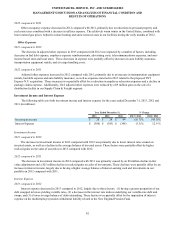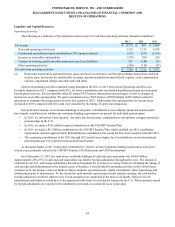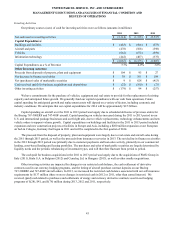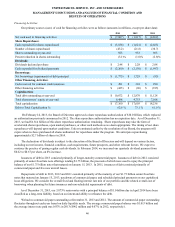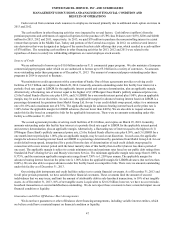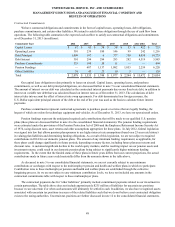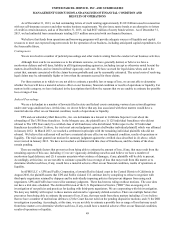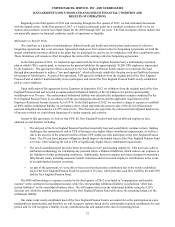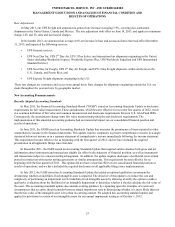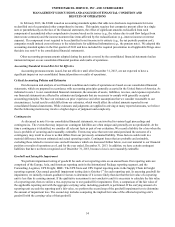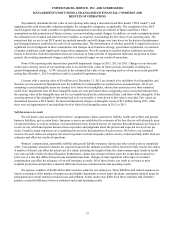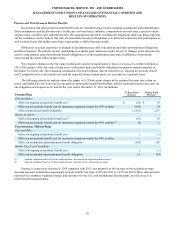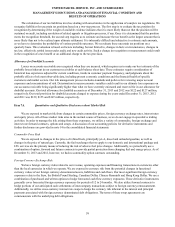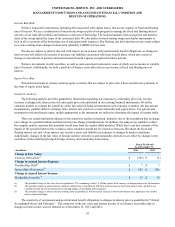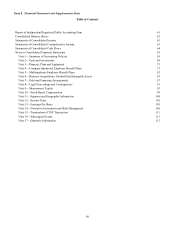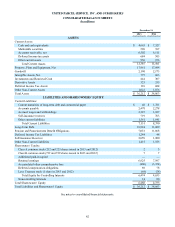UPS 2013 Annual Report Download - page 64
Download and view the complete annual report
Please find page 64 of the 2013 UPS annual report below. You can navigate through the pages in the report by either clicking on the pages listed below, or by using the keyword search tool below to find specific information within the annual report.UNITED PARCEL SERVICE, INC. AND SUBSIDIARIES
MANAGEMENT'S DISCUSSION AND ANALYSIS OF FINANCIAL CONDITION AND
RESULTS OF OPERATIONS
52
Beginning in the third quarter of 2012 and continuing through the first quarter of 2013, we had settlement discussions
with the Appeals team. In the first quarter of 2013, we reached settlement terms for a complete resolution of all excise tax
matters and correlative income tax refund claims for the 2003 through 2007 tax years. The final resolution of these matters did
not materially impact our financial condition, results of operations or liquidity.
Multiemployer Benefit Plans
We contribute to a number of multiemployer defined benefit and health and welfare plans under terms of collective
bargaining agreements that cover our union represented employees. Our current collective bargaining agreements set forth the
annual contribution increases allotted to the plans that we participate in, and we are in compliance with these contribution rates.
These limitations will remain in effect throughout the terms of the existing collective bargaining agreements.
In the third quarter of 2012, we reached an agreement with the New England Pension Fund, a multiemployer pension
plan in which UPS is a participant, to restructure the pension liabilities for approximately 10,200 UPS employees represented
by the Teamsters. The agreement reflects a decision by the New England Pension Fund's trustees to restructure the fund
through plan amendments to utilize a "two pool approach", which effectively subdivides the plan assets and liabilities between
two groups of beneficiaries. As part of this agreement, UPS agreed to withdraw from the original pool of the New England
Pension Fund of which it had historically been a participant, and reenter the New England Pension Fund's newly-established
pool as a new employer.
Upon ratification of the agreement by the Teamsters in September 2012, we withdrew from the original pool of the New
England Pension Fund and incurred an undiscounted withdrawal liability of $2.162 billion to be paid in equal monthly
installments over 50 years. The undiscounted withdrawal liability was calculated by independent actuaries employed by the
New England Pension Fund, in accordance with the governing plan documents and the applicable requirements of the
Employee Retirement Income Security Act of 1974. In the third quarter of 2012, we recorded a charge to expense to establish
an $896 million withdrawal liability on our balance sheet, which represents the present value of the $2.162 billion future
payment obligation discounted at a 4.25% interest rate. This discount rate represents the estimated credit-adjusted market rate
of interest at which we could obtain financing of a similar maturity and seniority.
As part of this agreement, we believe that UPS, the New England Pension Fund and our affected employees have
obtained several benefits, including:
• The old pool of the New England Pension Fund has historically had, and would likely continue to have, funding
challenges; this represented a risk to UPS of having to face higher future contribution requirements, as well as a
risk to the security of the pension benefits of those UPS employees who participate in the New England Pension
Fund. The 50 year fixed payment obligation should improve the funded status of the New England Pension Fund
over time, while reducing the risk to UPS of significantly higher future contribution requirements.
• The newly-established pool provides better protections for new participating employers. This pool uses a direct-
attribution methodology for calculating any potential future withdrawal liabilities, which reduces our exposure to
the liabilities of other participating employers. Additionally, this pool contains provisions designed to maintain a
fully-funded status, including automatic benefit reductions and/or increased employee contributions in the event
of an underfunded situation occurring.
• As part of the agreement, we were able to freeze our hourly pension contribution rate to the newly-established
pool of the New England Pension Fund for a period of 10 years, which provides cash flow visibility for both UPS
and the New England Pension Fund.
The $896 million charge to expense recorded in the third quarter of 2012 is included in "compensation and benefits
expense" in the statement of consolidated income, while the corresponding withdrawal liability is included in "other non-
current liabilities" on the consolidated balance sheet. We will impute interest on the withdrawal liability using the 4.25%
discount rate, while the monthly payments made to the New England Pension Fund will reduce the remaining balance of the
withdrawal liability.
Our status in the newly-established pool of the New England Pension Fund is accounted for as the participation in a new
multiemployer pension plan, and therefore we will recognize expense based on the contractually-required contribution for each
period, and we will recognize a liability for any contributions due and unpaid at the end of a reporting period.


